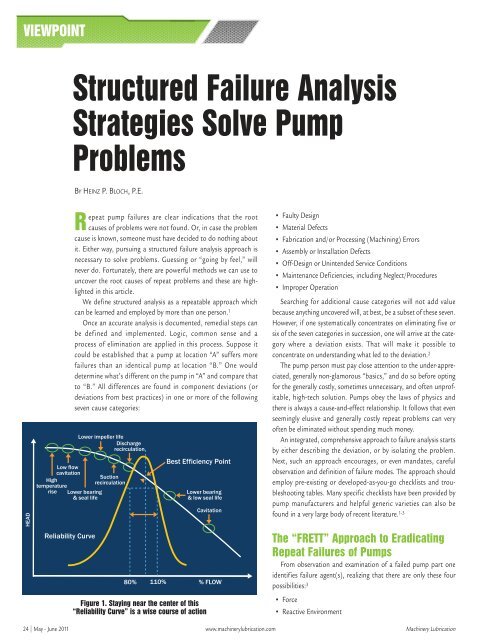Machinery Lubrication May June 2011 - Welcome to ECN Digital ...
Machinery Lubrication May June 2011 - Welcome to ECN Digital ...
Machinery Lubrication May June 2011 - Welcome to ECN Digital ...
Create successful ePaper yourself
Turn your PDF publications into a flip-book with our unique Google optimized e-Paper software.
VIEWPOINT<br />
HEAD<br />
Low flow<br />
cavitation<br />
High<br />
temperature<br />
rise<br />
Structured Failure Analysis<br />
Strategies Solve Pump<br />
Problems<br />
BY HEINZ P. BLOCH, P.E.<br />
Repeat pump failures are clear indications that the root<br />
causes of problems were not found. Or, in case the problem<br />
cause is known, someone must have decided <strong>to</strong> do nothing about<br />
it. Either way, pursuing a structured failure analysis approach is<br />
necessary <strong>to</strong> solve problems. Guessing or “going by feel,” will<br />
never do. Fortunately, there are powerful methods we can use <strong>to</strong><br />
uncover the root causes of repeat problems and these are highlighted<br />
in this article.<br />
We define structured analysis as a repeatable approach which<br />
can be learned and employed by more than one person. 1<br />
Once an accurate analysis is documented, remedial steps can<br />
be defined and implemented. Logic, common sense and a<br />
process of elimination are applied in this process. Suppose it<br />
could be established that a pump at location “A” suffers more<br />
failures than an identical pump at location “B.” One would<br />
determine what’s different on the pump in “A” and compare that<br />
<strong>to</strong> “B.” All differences are found in component deviations (or<br />
deviations from best practices) in one or more of the following<br />
seven cause categories:<br />
Lower impeller life<br />
Discharge<br />
recirculation<br />
Lower bearing<br />
& seal life<br />
Reliability Curve<br />
Suction<br />
recirculation<br />
Best Efficiency Point<br />
Lower bearing<br />
& low seal life<br />
Cavitation<br />
80% 110% % FLOW<br />
Figure 1. Staying near the center of this<br />
“Reliability Curve” is a wise course of action<br />
• Faulty Design<br />
• Material Defects<br />
• Fabrication and/or Processing (Machining) Errors<br />
• Assembly or Installation Defects<br />
• Off-Design or Unintended Service Conditions<br />
• Maintenance Deficiencies, including Neglect/Procedures<br />
• Improper Operation<br />
Searching for additional cause categories will not add value<br />
because anything uncovered will, at best, be a subset of these seven.<br />
However, if one systematically concentrates on eliminating five or<br />
six of the seven categories in succession, one will arrive at the category<br />
where a deviation exists. That will make it possible <strong>to</strong><br />
concentrate on understanding what led <strong>to</strong> the deviation. 2<br />
The pump person must pay close attention <strong>to</strong> the under-appreciated,<br />
generally non-glamorous “basics,” and do so before opting<br />
for the generally costly, sometimes unnecessary, and often unprofitable,<br />
high-tech solution. Pumps obey the laws of physics and<br />
there is always a cause-and-effect relationship. It follows that even<br />
seemingly elusive and generally costly repeat problems can very<br />
often be eliminated without spending much money.<br />
An integrated, comprehensive approach <strong>to</strong> failure analysis starts<br />
by either describing the deviation, or by isolating the problem.<br />
Next, such an approach encourages, or even mandates, careful<br />
observation and definition of failure modes. The approach should<br />
employ pre-existing or developed-as-you-go checklists and troubleshooting<br />
tables. Many specific checklists have been provided by<br />
pump manufacturers and helpful generic varieties can also be<br />
found in a very large body of recent literature. 1-3<br />
The “FRETT” Approach <strong>to</strong> Eradicating<br />
Repeat Failures of Pumps<br />
From observation and examination of a failed pump part one<br />
identifies failure agent(s), realizing that there are only these four<br />
possibilities: 3<br />
• Force<br />
• Reactive Environment<br />
24 <strong>May</strong> - <strong>June</strong> <strong>2011</strong> www.machinerylubrication.com <strong>Machinery</strong> <strong>Lubrication</strong>


